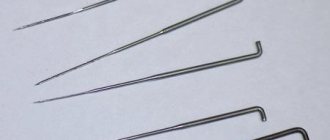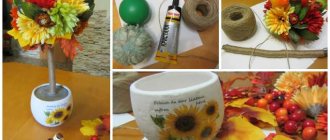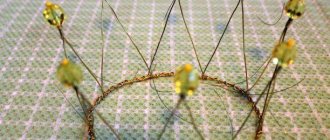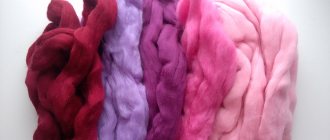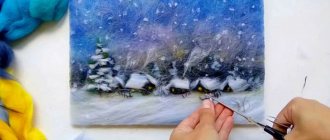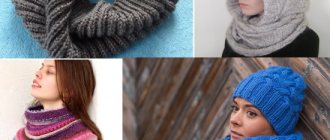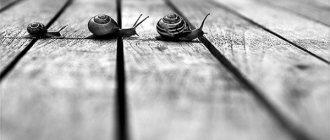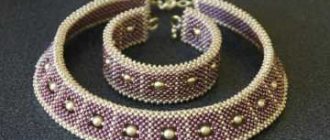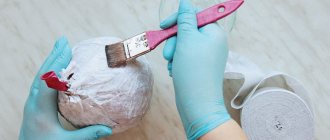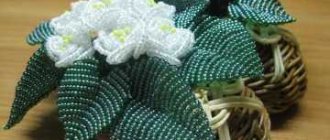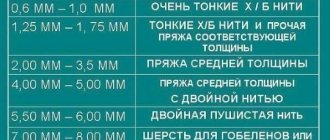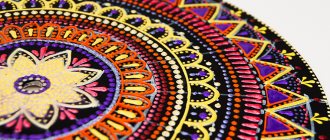Why does wool fall off?
Felt (English) – [noun] felt, felt; [verb] to felt wool, to knock down felt
I think it wouldn’t hurt to start by finding out the answer to the most important question – why does wool fall off? It's all in its structure! Remember, not so long ago there was an advertisement on TV for a shampoo that made your hair smooth and silky? Then they showed the ugly split ends in close-up. So, sheep's wool in normal condition looks about the same =)
Comparison of human hair and sheep wool. Are there many differences?
Because of this “layering,” human hair can even form tangles and “fall off.” But what is not good for our hair is good for felting. It is this structure of sheep wool that allows you to create wonderful toys, clothes, felt boots, carpets and much more.
Naturally, not only sheep’s wool is suitable for felting. You can use alpaca, camel, llama and yak wool, as well as cashmere, anagora and mohair.
Who wants a sheep? =)
So…
Felting (felting, felting) is the process of creating various products from unspun wool by interlocking and interweaving its fibers in various ways.
There are many different types of felting - dry felting, wet felting, nuno felting, felting of knitted items. Below I will discuss the main techniques.
Basic dry felting techniques for beginners
First of all, let's get acquainted with the technique of dry felting wool. Although it appeared much later than wet felting, it is currently gaining more and more popularity. With a regular needle you can create truly unique creations! Here, take a look at the works of famous masters
I want to warn you that this type of creativity is not suitable for children under 10 years old and those who like to create while watching TV (although I do this). If you are too distracted, you can pierce your finger right through - the needles are very sharp, and the notches are good at tearing the skin.
A felting needle is a thin tool, shaped like the letter L and equipped with fine notches. With its help, the fibers are easily tangled, and the dry felting technique itself is similar to creating a three-dimensional sculpture, where instead of plasticine there is soft, pliable wool.
Triangular felting needles are one of the most popular felting needles today. They are easiest to get at craft stores.
Dry felting technique - felting wool using a needle
- Having separated the wool from the unspun sliver, rub it a little between your palms, tangling the fibers. Then roll it into a tight cylinder.
- Let's proceed directly to the felting process. We insert the needle deeply, first of all compacting the workpiece inside. Gradually turn it, falling evenly. The ball will be compacted and its surface will be leveled.
- As the workpiece compacts, you should change the needle to a thinner one. If the figure no longer deforms when compressed, you can stop felting. To create a relief, it is necessary to process the same place with a needle many times.
Simple video for beginners:
For inspiration: video of the creation of a wonderful mouse from Elena Fedoryak
Tips for beginner felters
Tip 1. After pulling the wool out of the combed ribbon, rub it between your palms, this will tangle the fibers and make them easier to tangle.
Tip 2. You can determine whether the desired density has been achieved by compression. After deformation, the product returns to its original shape. Please note that if you overdo it, the wool fibers will begin to tear.
Tip 3. When felting large items, use a sliver for the inside, this allows you to save more expensive wool. (It is possible, but not particularly recommended, to use padding polyester)
Application
You can distinguish applique as a subtype of dry felting. In this case, we roll the wool onto some kind of base, mainly felt or wool. Using wool you can decorate clothes, give new life to old things, for example.
Master class on felting toys
To quickly master wool felting for beginners, it is worth taking a master class on felting toys. Let's look at the process step by step:
- prepare the base - a brush or sponge;
- take the material and roll it between your palms;
- put it on the base and begin to tangle it with a needle, inserting it in and out of the hairball;
- first you need to felt the middle well, and then the edges;
- the needle must be held at right angles to the future toy;
- if the product turns out uneven or you need to add volume in certain places, you should add raw materials and sink this place again;
- a similar operation is performed when changing colors;
- if you need to felt parts together, the joints are left unfelt, the fibers of one part are mixed with the fibers of the mating part using the same needle;
- When final processing a part or an entire toy, grinding is performed: the needle is inserted shallowly, and punctures are made at a short distance from each other.
You can check the readiness of the product by knocking: if the toy is well felted, it will knock with the same sound as when you hit a table with your finger.
Wet felting from wool
What is wet felting from wool? – This is a classic method of felting wool using soap, known since ancient times.
I will briefly describe the process:
The wool layout is soaked in a hot soapy solution, then ironed and rubbed in different directions, gradually increasing the pressure. To facilitate work in the initial stages, a vibratory grinder is often used. You get a canvas - felt.
Advice. When making patterns for the desired product, keep in mind that when wet felting, the wool will shrink by 30-40 percent
Wet felting technique
This step-by-step description of the wet felting technique will help beginners understand (and, I hope, motivate to try and enjoy) the process =)
You will need:
- unspun wool,
- bubble wrap,
- bamboo napkin,
- soap,
- warm water.
Excerpt from MK by rosiepink
- Separate identical shreds of wool about 8 centimeters long from the woolen tape. Place them on bubble wrap in one direction, slightly overlapping each other. Similarly, we lay out 3-4 layers, the wool fibers in each of which are perpendicular to the previous one.
- The last layer can be applied with a pattern made from scraps of woolen thread, scraps of wool, etc.
- Prepare a soap solution. To do this, dissolve soap in warm water (there is a special soap for wet felting, which is gentle on the skin of your hands, but you can also use baby soap, liquid soap, or even dishwashing detergent) - whatever you have on hand. We wet our workpiece and cover it with a net or bubble wrap.
Using soft circular movements, stroke the fur in all directions. Gradually increase the pressure. This stage can be completed when individual fibers no longer separate from our fabric. - Place the workpiece along with the film on a bamboo napkin and roll it into a tight roll. We wrap this structure in a towel - this will help remove excess water. We ride back and forth a hundred times. Then we unfold it, turn the canvas 90 degrees and make a roll again.
- When falling, the canvas will decrease by 25-30 percent. Rinse the finished canvas in warm water and leave to dry. Do not wring - just squeeze slightly to remove some of the water.
Carpets, paintings, clothes, bags, jewelry and accessories are made this way. Visually about wet felting:
What is felting wool?
Wool for felting is taken only from animal origin. Artificial material does not give the desired results due to differences in the structure of the fibers. But even natural wool has significant differences between subspecies and each individual type cannot be used for every craft.
Production
Wool for felting is produced in various countries. It is distinguished by quality, color, and thickness of the fibers. The most valuable is the super-thin material, which is produced in England, Italy, New Zealand, and Germany. This is merino carded, from which thin scarves, clothing and other items are created. It is not prickly and quite gentle.
How to choose
It’s easy to choose wool for felting, but when purchasing, you need to clarify that it will be suitable for a specific type of needlework. There are varieties that are not suitable for felting and are used for spinning. They do not form felts during processing and remain skeins, regardless of the type of impact.
For dry
Thin, semi-fine types of Trinity wool are produced in Russia. It is found often, has a huge number of shades and is inexpensive. It falls off easily and quickly, but has a lot of hard hairs that have to be pulled out. It is not suitable for wet felting. Another significant disadvantage is that the material often sheds.
The composition often contains hard hairs that may need to be combed out.
In general, carding is good for dry felting. It lends itself well to felting, quickly forms felts and does not require prolonged exposure.
For wet
Thick Peruvian wool is absolutely not suitable for wet felting; it is better to use thin and superfine wool. It allows you to create thin and soft products that do not prick. The best wool is made in Italy. Merino carded, brought from this country, is most valued by needlewomen, although it requires more careful handling.
Kinds
There are different types of felting material. They can be represented by the manufacturing method, shades, the presence of hard hairs, and so on. It is worth choosing a specific option based on your final goals.
Leonardo
Leonardo is an Italian wool that is valued by needlewomen. Excellent for wet felting. It is used to create clothes, scarves and much more. A distinctive feature is that things made from such material are practically not scratchy. But it is worth considering that such fiber is quite expensive.
Carded
Cuardoches are excellent for dry felting. It falls quickly, and the hairs themselves are quite strong and durable. There is no need to tear them apart during the manufacturing process. This material is also called wool wool. That is, this is wool that has been passed through a carding machine with hard card brushes. Outwardly, it resembles cotton wool, and the fibers in it are multidirectional.
There is a thin and semi-thin option. Supplied from domestic manufacturers, as well as from Latvia, Estonia, Bulgaria.
Suitable for making paintings, handbags, slippers, hats and other products.
White
White wool or Corriedale is the second most important wool in felting after merino. Its main distinguishing feature is its pure white color and bright shine. It is excellent for dry felting. It has a small thickness and a high degree of elasticity. If it is used in wet felting, it is usually mixed with Merino. This type of wool will make the craft heavier and denser. It is important to note that it is a little prickly.
Kyrgyz
Kyrgyz wool for felting is a fairly strong and elastic material, from which handbags and slippers are also made. Toys. It is excellent for dry felting, and products made from it are especially wear-resistant. It is not so good for making clothes, as it can be very scratchy due to the presence of hard fibers. Has a rich color palette.
Italian
Italian wool is one of those that is valued the most. It is distinguished by its luxurious quality, as well as its softness and tenderness. One drawback is that its cost is slightly higher than that of analogues from the CIS.
It has a slight sheen and is well suited for dry and wet felting.
